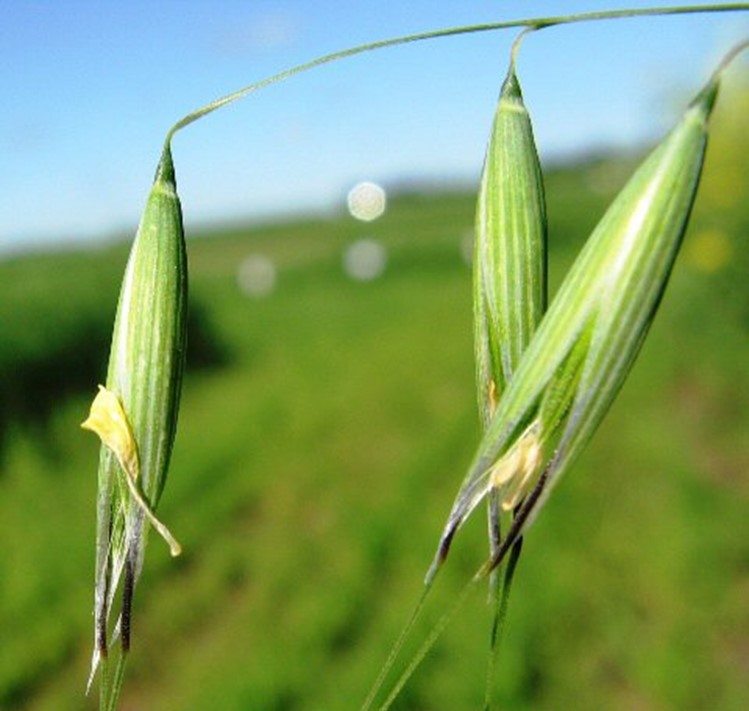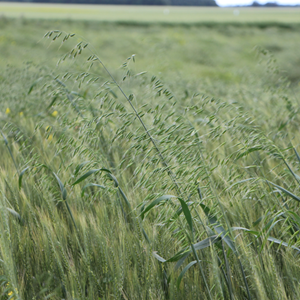Managing Herbicide-Resistant Wild Oats in Peas & Lentils
By Paige Kennedy, BSc.Agr., AAg
Background
Wild oats are an annual grassy weed that are very similar to cultivated oats. However, wild oats differ in that they pose a significant problem for producers in Western Canada due to their ever-increasing herbicide resistance. High presence of wild oats in grain and pulse crops can reduce yields, increase seed cleaning fees, and decrease the quality – and therefore profit – of a crop.
Wild oats were introduced to Western Canada in the late 1800’s. It is thought that wild oat was brought over with settlers at this time, and it has been a challenge for Prairie producers ever since. Specific characteristics and growth habit adaptations have engendered wild oats with their prolific longevity in Saskatchewan soils.
Wild oats can be identified by their high, membranous ligule and their lack of auricles (Figure 1). Wild oats have hairy leaf margins and appear quite similarly to cultivated oats. A tell-tale sign of wild oats versus cultivated oats, however, is the presence of long black awns in the wild species (Figure 2). Depending on environmental conditions, you may also be able to notice a counterclockwise twisting pattern in the leaves. Wild oats typically germinate in early to mid-spring when cool, wet conditions are optimal for wild oat germination. Wild oats grow rapidly, tillering within one month of emergence and usually reaching the reproductive stage by early July. The reproductive stage can last up to six weeks after which mature seeds at the tip of the main panicle are prone to ripening and dropping to the ground before the rest of the panicle has matured, Providing a continual flow of mature wild oat seeds to the soil can occur if not controlled early in the growing season. Full maturity is usually reached by mid-August, aligning with the onset of pulse harvest and pre-harvest activities in the prairies.

Source: Government of Manitoba Agriculture

Source: Government of Manitoba Agriculture
Wild oats have evolved impressive – and problematic – adaptations over time that make them a highly competitive weed species. Wild oats have an impressive ability to germinate at depth, dig themselves into the soil using their twisted awn, return to dormancy, and an extensive viability in the soil weed seed bank for many years. While most wild oat seeds germinate between 2–5 cm depth in cool, moist soil, they can germinate as deep as 20 cm below the soil surface if adequate moisture is available. Wild oats require soil contact and full soil coverage to initiate germination. Their unique adaptation to ensure soil coverage is the unwinding and rewinding of the twisted awn with wetting and drying. As the seed coat or awn moistens it unwinds, and when it dries it twists or rewinds again. Over time, with wetting and drying cycles, the awn is slowly able to dig the seed below the soil surface with this corkscrew-like mechanism, ensuring continuation of the progeny and building of next year’s wild oat seed bank in the soil.
In addition to their self-seeding mechanism, wild oats can break dormancy and return to dormancy if optimal conditions are not met. The seeds may break dormancy in warm dry conditions and germinate if there is enough moisture available. However, if dormancy is broken only to find that adequate moisture is not present, the seeds can return to dormancy again. In general, 80% of wild oat seeds will germinate in the first spring following maturation. By the following year, 97% of the seeds will have germinated, leaving the last 3% to remain alive (but dormant) in the weed seed bank for up to 12 years.
Wild oats have been a consistent challenge for growers in Saskatchewan holding strong as one of the top three most abundant weeds in the Prairies since the 1970’s. In the latest survey results from 2021, wild oats were the second most abundant weed on the prairies behind green foxtail. Herbicide-resistant wild oats are increasing in prevalence across Western Canada and represent a significant concern to growers. With such broad-acre occurrence, wild oats are a weed almost every grower in Saskatchewan must deal with in any given growing season.
Wild Oat Herbicide Resistance: How does it happen?
In the last few decades of the 20th century, there were some impressive advancements in herbicide development and, as such, control of wild oats seemed to be attainable in Western Canada. Growers and researchers were optimistic about the control these new herbicide products offered. However, while wild oat abundance may have dipped slightly, herbicide resistance developed, and wild oats continue to be problematic for Prairie growers. There have been very limited advancements in terms of herbicide development in the last 20–30 years: herbicides that were effective for controlling wild oats in the 1970’s have reduced efficacy today, as herbicide resistance has rapidly increased with intensified rotations and farming practices.
Controlling wild oat populations in-crop has historically fallen to the use of Group 1 and 2 grassy herbicides. This reliance on limited groups has led to intense selection pressure and multiple modes of resistance mechanisms in wild oat populations by both target site resistance and enhanced metabolism resistance. Target site resistance refers to the natural mutations that randomly occur in plant populations. When selection pressure is high, biotypes that have mutated resistance for a given herbicide have an advantage over those that have not adapted the same way, and the resistant biotype prevails. Employing herbicide rotation practices can help to limit or slow this type of resistance. Metabolic resistance, however, occurs when plants “learn” how to degrade the herbicide into less-toxic metabolites before the herbicide active gets to the target site. Metabolic resistance builds up over time, starting with the plant tolerating a small dose of the herbicide, and increasing their tolerance slowly over time. In this way, wild oats can survive despite herbicide application. Metabolic resistance is not specific to any one mode of action, so herbicide rotation is not an effective way to combat metabolic resistance.
As a result, the deterioration of herbicide efficacy has contributed to the development of wild oat biotypes resistant to Groups 1, 2, and 15 (this includes actives formerly classified as group 8) herbicides, which have been found in all Prairie provinces. In Manitoba, biotypes have even been found that are not only resistant to Groups 1, 2, and 15 (formerly group 8) but also Group 14. Group 14 does not historically have control or applications specifically targeting wild oat populations. The occurrence of a Group 14 resistant biotype is believed to be the result of multi-group metabolic resistance development. The Group 14 cross-resistant biotype was first identified in a growers field in MB and subsequently propagated for further study in AB. The reality of managing multi-group cross-resistance is quite bleak, as it leaves Group 3 as the only remaining herbicide group with no recorded resistant wild oat biotypes for some Prairie growers.
The Prairie weed survey conducted between 2014 and 2017 tested thousands of wild oat samples for resistance to Groups 1 and 2 herbicides. The study revealed that 69% of wild oats sampled were of a herbicide-resistant biotype. 62% of the samples were resistant to Group 1 herbicides acetyl CoA carboxylase (ACCase) inhibitors, 34% were resistant to Group 2 herbicides, acetolactate synthase (ALS) inhibitors, and 27% were resistant to both Groups 1 and 2 herbicides. This is up significantly from the same survey completed between 2007 and 2009, which found 44% Group 1 resistance, 12% Group 2 resistance, and 8% Groups 1 and 2 resistance. The large jump in Group 2 herbicide resistance in wild oats reported in the 2007–2009 survey compared to the 2014–2017 survey is attributed to the increased selection pressure for Group 2 resistance as the use of these herbicides increased in response to combating Group 1 resistance. Due to broad herbicide resistance in wild oat, Group 3 herbicides may represent one of the best (or only) options for suppressing or controlling wild oats in pulses in Western Canada. However, the development of Group 3 herbicide resistant wild oat biotypes is a concern as well.
Wild Oat in Peas & Lentils

Source: Syngenta
Both peas and lentils are poor competitors against weeds and are highly susceptible to yield loss (20 to 40% yield loss attributed to weeds) (Figure 3). In 2022, Saskatchewan farmers seeded 3.7 million acres of lentils and 1.8 million acres of peas. Of herbicide options available for these acres, Group 1 and 2 actives quizalofop, clethodim, imazamox, and imazamethapyr are currently the only in-crop options available. The critical weed-free period for peas and lentils occurs from two to five nodes or one to three weeks post-emergence, while the optimum herbicide timing is between five and six nodes. This translates to a very limited application window for controlling hard to kill weeds. These challenges have played a significant role in the continued increase in resistant wild oat biotypes and pose serious risks to production and profitability for pea and lentil growers in Western Canada.
For Saskatchewan pulse producers, the only available in-crop wild oat control options are Group 1 dims and fops and Group 2 imis. At this time, the best choice in terms of herbicide options are likely pre-seed or pre-emergent and post-harvest applications of Groups 3 (active: ethalfluralin, such as Edge®), 15 (formerly group 8) (active: triallate, such as Avadex® or Fortress®), or 14+9 (active: pyroxasulfone, such as Focus® or Heat® Complete tank mixed with glyphosate) herbicides. It should be noted again that Group 15 (formerly group 8)-resistant wild oat biotypes are on the rise in Western Canada: farmers should monitor the efficacy of these herbicides in terms of wild oat kill. Additionally, growers should be aware that the Herbicide Resistance Action Committee (HRAC) and the Weed Science Society of America (WSSA) recently made some important changes to herbicide chemical groupings. These changes include the elimination of Group 8 and transfer of previous Group 8 herbicides into Group 15. This is due to recent findings which have shown Group 8 and Group 15 herbicides have similar modes of action.
However, former Group 8 herbicides may still be used in rotation with Group 15 herbicides as prior to these changes. Refer to table 1 for a visual description of which herbicide actives may be used for which herbicide resistant weed biotypes.
Table 1: Herbicide resistant biotype table demonstrating which herbicide groups can be used to effectively control specific herbicide resistant weed biotypes
| HR Biotype | Group 1 | Group 2 | Group 3 | Group 14 | Group 15 (includes former Group 8 actives) |
|---|---|---|---|---|---|
| Gr.1 | |||||
| Gr.2 | |||||
| Gr.1+2 | |||||
| Gr.1+2+8 | |||||
| Gr.1+2+8+14 | |||||
| Gr.1+2+8+14+15 |
Control Options
Herbicides are not the only control option available. In fact, combining chemical controls with cultural or mechanical controls is always a good idea. According to the 2014–2017 prairie weed survey, herbicide resistance in wild oat could potentially be delayed if producers consistently employ more than one control practicecontrol practices such as herbicide group rotation, tank-mixing herbicide groups together, or combining chemical controls with cultural controls such as crop rotation.
Some wild oat control options growers may consider are:
- Increasing their seeding rate to have a more competitive crop that drowns out some of the weeds.
- Seeding early to reduce yield losses and improve the competitive advantage of the intended crop over wild oats.
- The use of precision fertilizer application techniques to fertilize the crop but limit additional nutrients provided to the weed.
- Herbicide stacking or tank-mixing herbicide groups together to mitigate selection pressure on a single herbicide group.
- Crop rotation to disrupt weed growth patterns and vary herbicide groups used.
- Manual panicle-clipping prior to wild oat maturation to reduce the plants’ contribution to the weed seed bank and keep wild oat populations as low as possible.
- Scouting fields for irregularly shaped weed patches or weed patches with no clear boundary – this may be an indication of herbicide-resistant wild oats.
- Mechanically crushing weed seeds during harvest using a seed destructor attachment on a combine (lab tests show promising results of up to 95% successful seed destruction, but field tests in the Canadian Prairies are still underway).
When seeding, there are some additional precautions farmers can employ to help mitigate yield loss caused by wild oats. Shallow seeding in a well-prepared seedbed and proper fertility can give the intended crop a head-start compared to wild oats. Well-timed or targeted tillage may be another option, wherein the soil is tilled just prior to seeding or emergence, or only small patches of the field are tilled where wild oats are of most concern. Using tillage as a control option should be carefully considered because of the detrimental soil effects also associated with tillage. If growers do decide to till, shallow tillage (<2” depth) is sufficient to kill off wild oats.
If growers discover a wild oat patch in their fields they think may be herbicide-resistant, they are advised to mow the weeds before seed- set. This will limit seed spread and reduce the chances of herbicide- resistant wild oat bio types contributing to the weed seed bank. Additionally, growers have the option to collect mature seed samples from such patches and send them to a lab to determine the presence of herbicide resistance. In Saskatchewan, growers can send their samples (samples that have not been treated with a pre-harvest aid i.e., glyphosate) to the Crop Protection Lab in Regina at a cost of $125 per sample for Saskatchewan residents. This lab tests for Groups 1, 2, and 8 resistant wild oats for more information visit the Crop Protection Lab website.
Future of Wild Oat Control
Wild oats are certainly a significant problem for our Prairie producers, and it is expected to continue this way into the future. Research on long-term efficacy of wild oat control practices like tillage and panicle clipping are ongoing. Overall, the use of best management practices (BMPs) for weed control is especially important when it comes to wild oats. More producers using BMPs on a consistent basis will aid in delaying herbicide resistance development and reduce yield losses as a result.
Recently, the Australian Herbicide Resistance Initiative (AHRI) research team discovered the world’s first known case of metabolism- based glyphosate resistance. The resistance was found in barnyard grass in a no-till, drip irrigated research site. This serves as a stark reminder to growers and researchers alike that evolution does not stop and new tools for controlling herbicide resistant weeds are badly needed in the agricultural industry.
If farmers are looking for additional information on wild oat control, they are encouraged to get in touch with the newly formed Resistant Wild Oat Action Committee (RWOAC).


